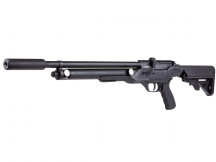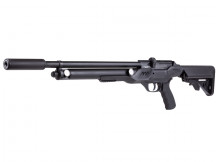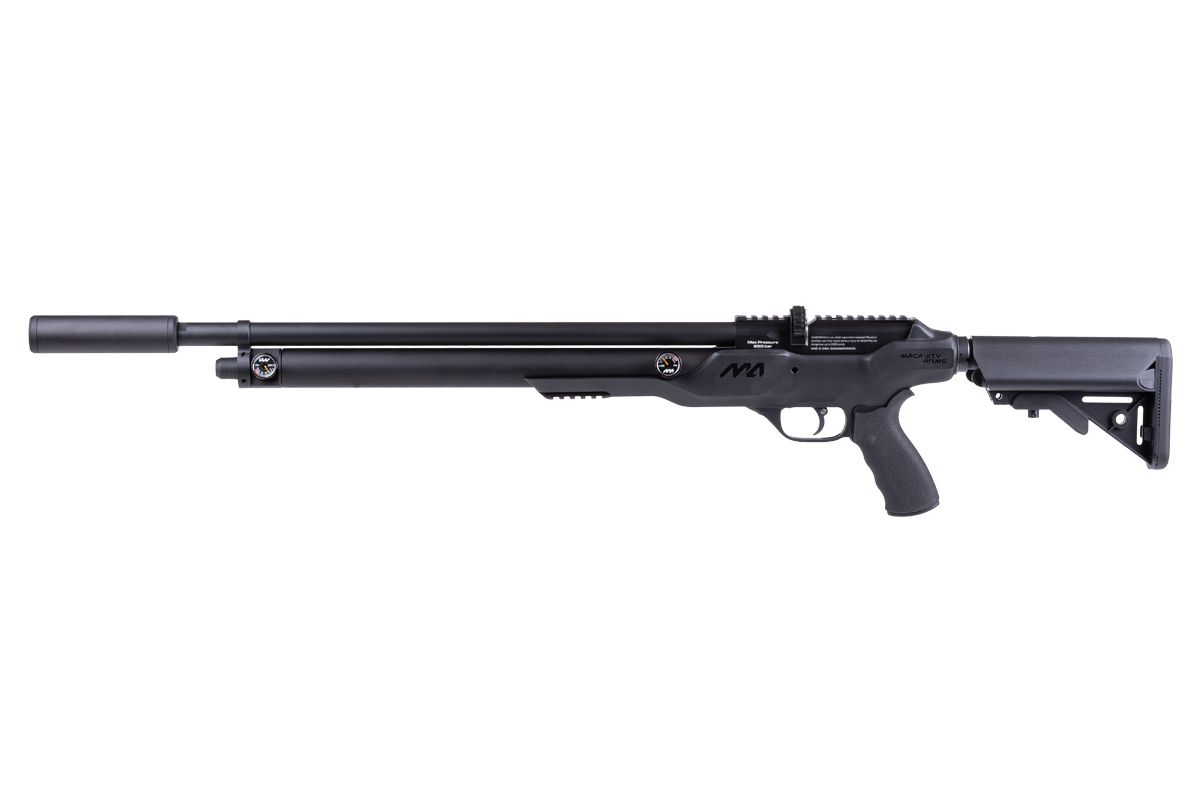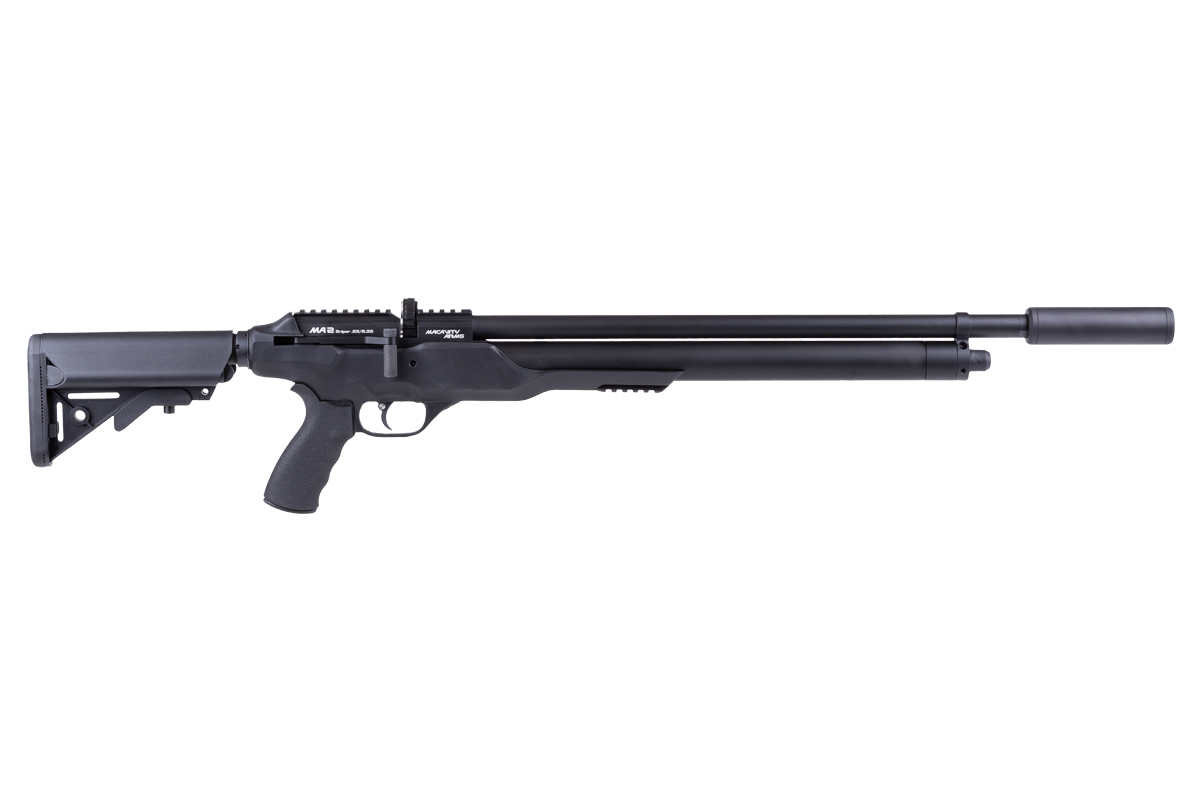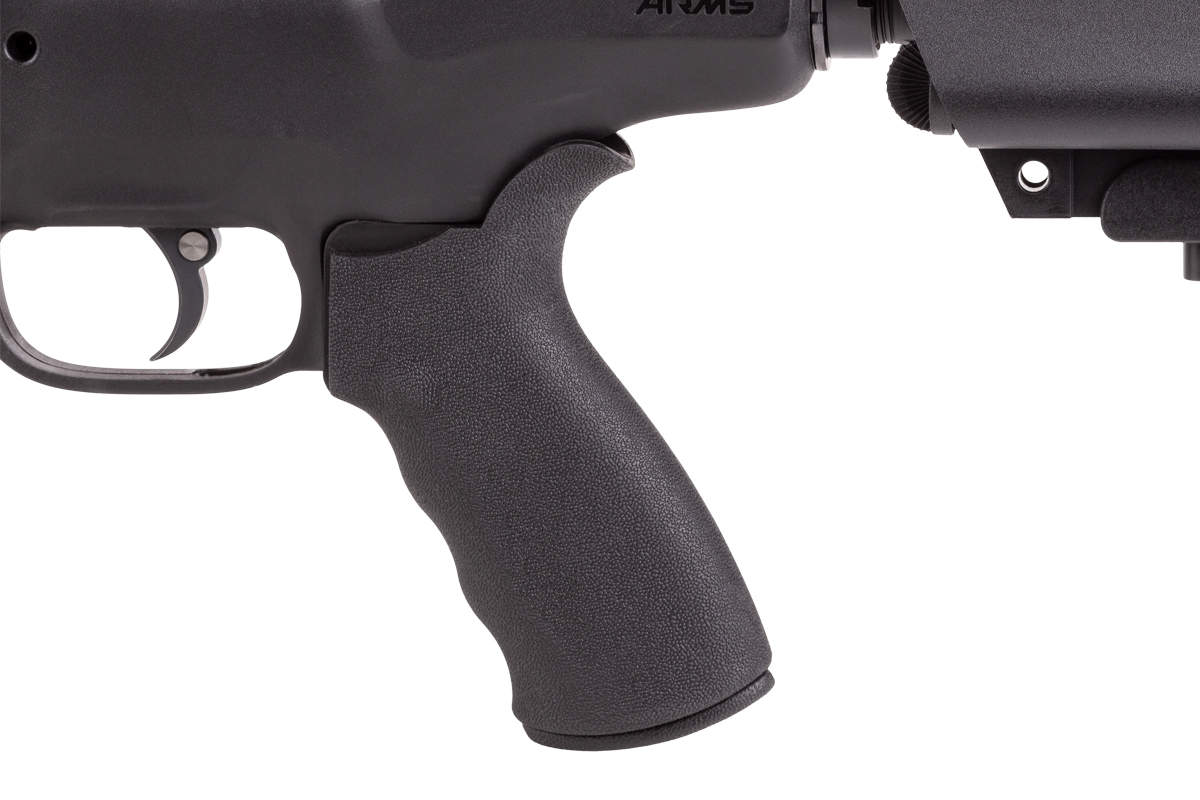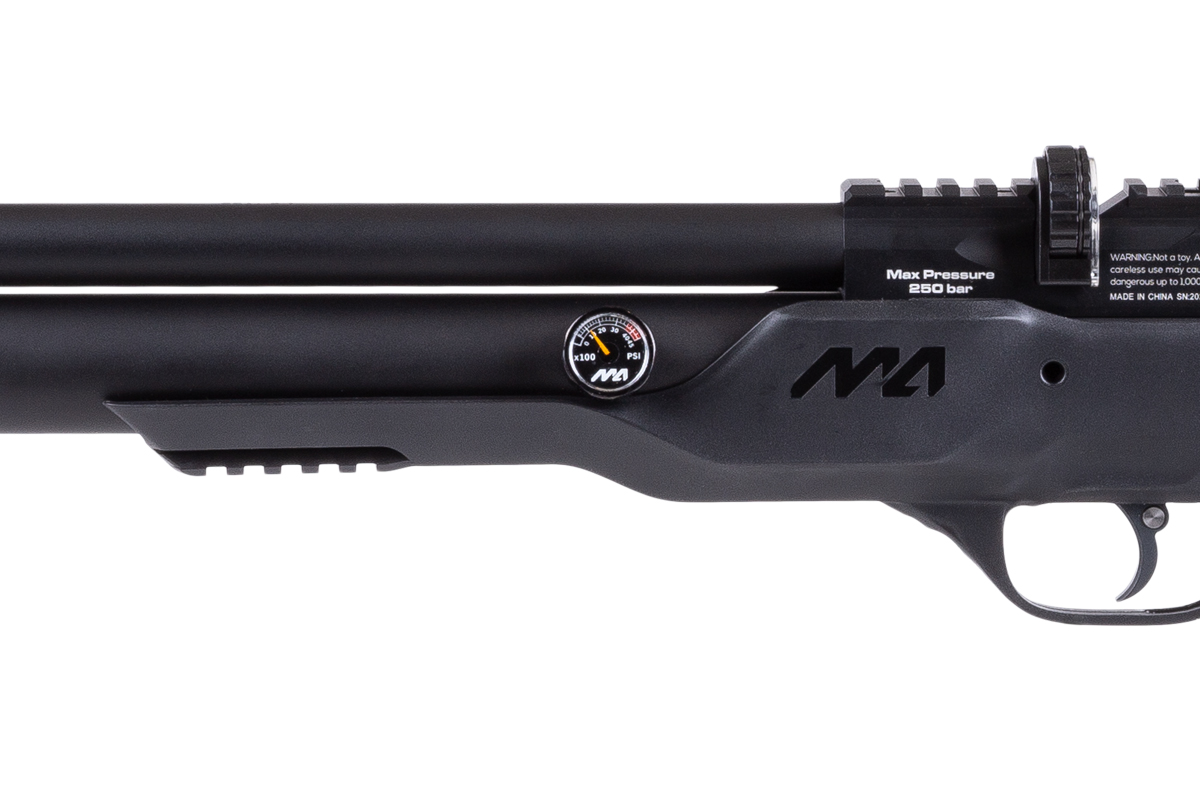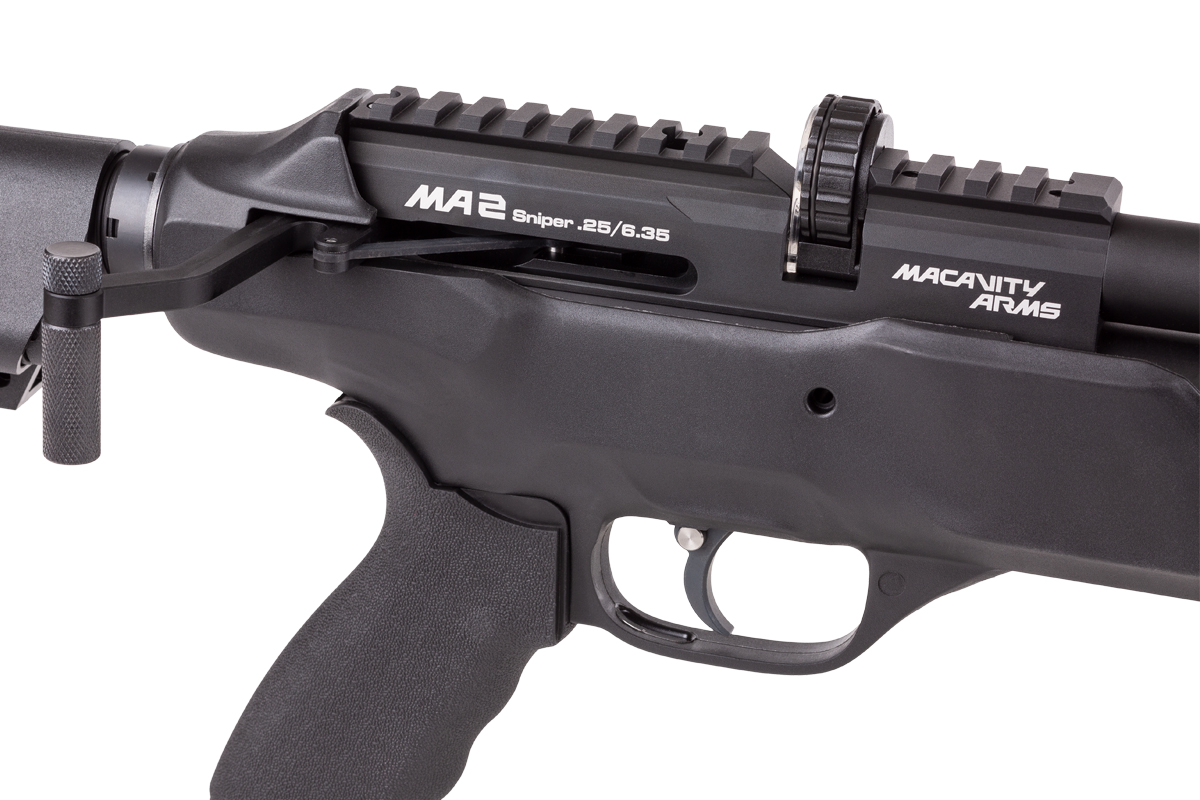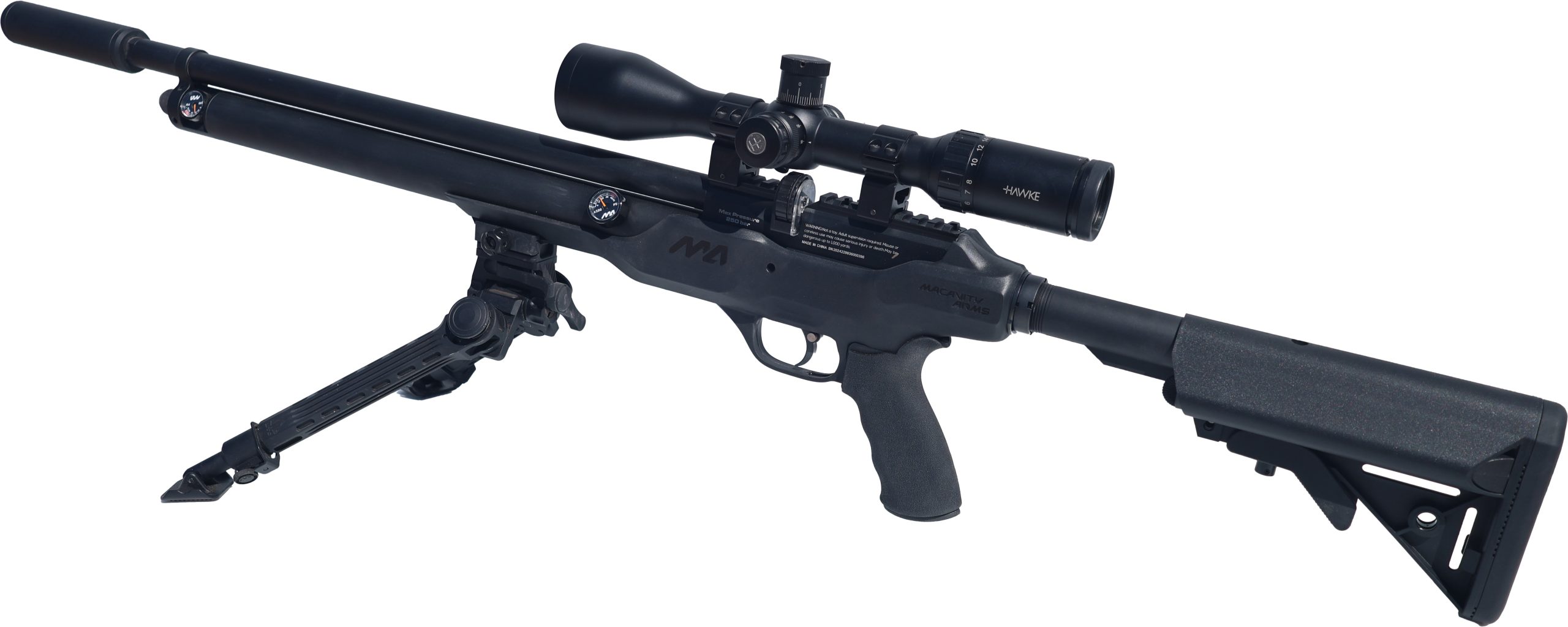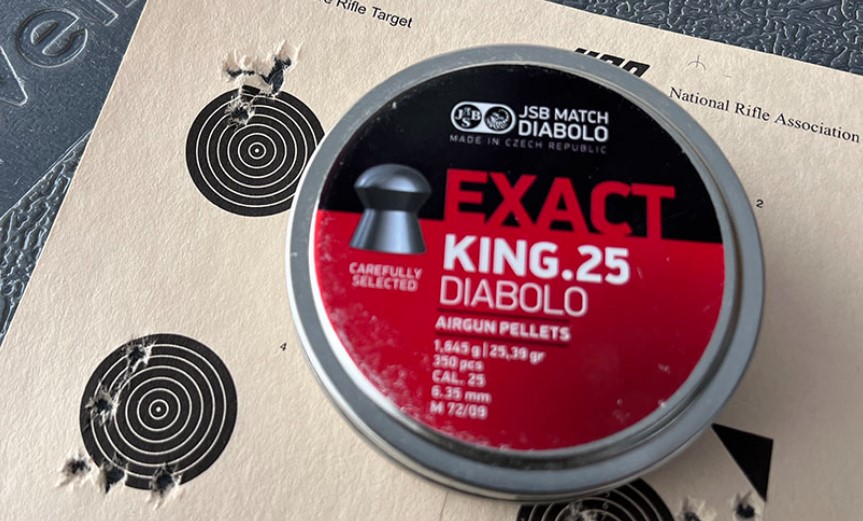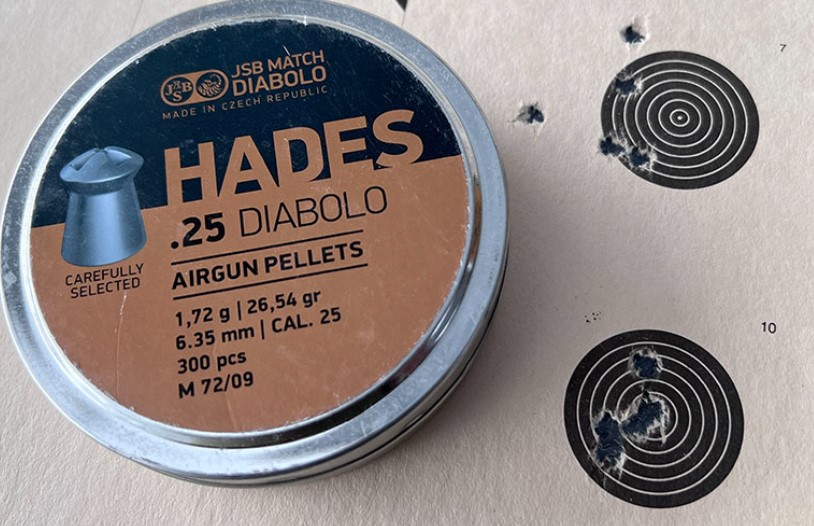Definitive Guide to Macavity Arms Agility MA2
The MA2 series ships in two variations, each in .22, .25, and .30. There's a long version and a short version. The primary differences are the barrel length, overall rifle length, air cylinder size, overall weight, and shot count. The MA2 Long has a 22" barrel with a total length of 41.1", and the MA2 Short has an 18" barrel and an overall length of 36.8". The rifles weigh 6.39 pounds and 5.95 pounds, respectively. The air cylinder capacity on the MA2 Long is 267cc, with the short dropping to 196cc. According to the marketing materials, power output remains consistent across both models, although we've not been able to independently confirm that at this time. The largest delta between the two models is probably shot count. The Long is stated to get a maximum of 60 shots, with the Short topping out at 30 shots. This would be consistent with our tests of the pre-production models, and we expect the same results for the production units. For those looking for a lighter, more compact version, the MA2 Short seems to be the perfect fit. For shooters looking for a high shot count and not minding the extra length and weight, the MA2 Long checks all the boxes. Now that we've looked at the primary differences let's take a detailed look at the M2 Long in .25.
The Macavity Arms Agility MA2 PCP pellet rifle ships securely in a partitioned foam shipping box with all the accessories in individual cutouts. We love the attention to detail here, as it ensures that each customer receives their MA2 in proper condition. While this is expected with high-end airguns, it's refreshing to see it implemented on a budget-class product. Each MA2 ships with an AR-style stock, wrench, three magazines, and an airgun suppressor. Customers will need to install the "buffer tube" and adjustable stock to the rear assembly and secure it with the included wrench. There is an indexed collar to help ensure proper alignment. Its simple yet elegant attention to detail like this makes the MA2 a cut above the rest in its class.
The grip is textured and tactile. The foregrip is minimalistic, with a front rail for accessories. We would like to see the stock have greater rigidity. The stock flex makes it less than ideal for full-on competitive benchrest shooting, but it's functional for everyday use. We've shot our MA2 from various attached bipods, bags, and fully supported "sleds." The results were consistent across the board.
As mentioned above, the overall weight is light compared to other airguns. The Long version weighs 6.39 pounds. Other airguns hit 8 and 9 pounds without optics, making the MA2 Long a welcome change and living up to the "Agility" branding.
Additional features include a slotted rail for optics, a two-stage adjustable trigger with a sub-2-pound trigger pull, dual gauges for regulator and reservoir pressure, and a rifled, choked, tensioned, shrouded barrel that's factory-tuned for optimal performance. Output can be tuned via an adjustable hammer spring and internally adjustable regulator. For this article, we did not make any adjustments to our sample. We shot it unmodified. Magazine capacity varies by caliber: 11 shots for .22, 10 shots for .25, and 8 shots for .30. Lastly, there's a bundled suppressor that can be fitted to the front unf threaded barrel endcap. The suppressor does not have any baffles but still provides decent sound dampening for our .25 test model.
Setup & Operation
Let's get our MA2 set up to shoot. You'll need to mount an optic before you can shoot, as the rifle does not come with open sights. For this guide, we've mounted a Hawke Vantage 30 WA 4-16x50 SF, 1/2 Mil Dot FFP IR scope. It's a good match for this rifle with decent optical clarity, first focal plane reticle, side focus parallax, and a 30mm tube. The mil-dot reticle provides plenty of aim points when adjusting for windage and elevation. Lastly, the 26 MRAD adjustment range provides plenty of usable adjustment for 100-yard benchrest shooting.
With your scope mounted, it's time to fill the MA2. There are two gauges for reference. The front gauge shows the primary pressure in the main cylinder. The MA2 operates from a 250 bar max fill pressure. The 2nd gauge provides a quick reference to the regulator pressure. The default reg pressures are as follows: .22 1300 (short) / 1600 (long), .25 1600 (short) / 1885 (long). Our MA2 is set to the factory regulator pressure, so we'll be shooting from the default 1885 PSI reg pressure.
To fill your MA2, connect your HPA air source to the front quick disconnect port and fill the cylinder to 250 bar. Double-check your gauges to make sure that you are at spec.
Your MA2 will ship with three magazines. Go ahead and fill your magazines with your desired pellets; we tested pellets vs. slugs for this guide and recommend pellets over slugs for general use, given that the MA2 ships with a choked barrel. To load the magazine, pull back on the cocking handle and insert the mag from the left side of the receiver. The mag will securely click into place. Close the cocking handle to seat the pellet into the breech. Your MA2 is not ready to fire. Acquire your target, release the manual safety, and gently squeeze the trigger. To fire again, pull back on the cocking lever and allow the auto-advancing magazine to rotate the next pellet into place. Push the cocking handle forward again, and you are ready to take your next shot.
Performance & Accuracy
Our .25 cal MA2 Long PCP rifle delivered 50 shots on the reg with an extreme spread of only 32 FPS and a standard deviation of 7.1. The average velocity was 913 FPS, shooting 25.4 grain JSB Kings. The average energy was 47 foot-pounds. That's pretty ideal, right out of the box. As mentioned above, the MA2 can be adjusted via the hammer spring as well as via the internal reg adjustment. However, we would recommend only using the hammer spring as it's much easier for the average shooter to manage. Regardless, make sure that you have a chronograph before you try any adjustments. If you can't measure your changes, then you won't know if you are getting the desired results.
We could have pushed it to 60 shots but with an increased spread. If you are target shooting inside 50 yards, then you can certainly get the 60 (probably more) shots on the spec sheet. For optimal accuracy, you want to make sure that your cylinder pressure is greater than your reg pressure. There may be some slight variations between rifles, so keep an eye on your gauges to know when you need to refill your MA2.
The MA2 air rifle seems to like JSB pellets. While we tested other brands, JSB proved to be the most consistent. We tested the 25.39gr JSB Kings, the 33.95gr JSB King Heavy MKII, and the 26.54gr Hades. Results from all three pellets were remarkably consistent. The variation between groups was marginal. We are very impressed with how well the MA2 puts lead on target.
The conditions were less than ideal for our testing. With nearly constant 18 mph sustained winds and 25+ mph gusts, we did our best to shoot groups during calm periods. Interestingly enough, we got some results that clearly show how the MA2 will perform in calm conditions and when trying to buck the wind. Let's take a look at these results, which were all shot off a bipod at 50 yards.
Here are two shot groups using the 25.39gr JSB Kings. The first group was shot in calm conditions, which quickly changed during the 2nd group. The extreme spread was 14 FPS with a standard deviation of 3.9 FPS. The average velocity was 880, and the average energy was 43.7 FPE. We did try to use our mil-dots to adjust to the center for the second group, but the windy conditions prevailed.
Our next groups were more consistent as the conditions remained relatively stable during the test. The JSB King Heavies did well in the wind at 50 yards. If these were our pellets of choice, we'd want to adjust our scope to bring the groups to the center, but this gives us an idea of how these pellets will group. Our ten shots had an extreme spread of 10 FPS and a standard deviation of only 3.4 FPS. The average velocity was 778, with an average energy of 45.7 FPE, which is a little higher than we saw from the 25.39gr Kings.
The most interesting results came from the 26.54gr JSB Hades. There was a lot of wind during the first group and almost no wind in the second. No hold adjustments were made between the groups. Both groups were shot, holding dead center to the bull. Under calm conditions, the JSB Hades will deliver 5 shots in the black almost every time. These 10 shots saw an extreme spread of 12 FPS with a standard deviation of 3.5 FPS. The average velocity was 891, and the average energy was 46.8 FPE.
Under calm conditions, the MA2 will deliver repeatable results throughout the shot string. It's one of the most consistent airguns we've tested.
Summing Up
As you can see, the Macavity Arms Agility MA2 regulated PCP air rifle .25 cal Long, is a great shooting airgun. It's easy to handle and shoot and delivers consistently accurate results throughout the usable pressure curve. When you consider the budget-minded price point, you start to wonder how Macavity Arms managed to pull it off. They've brought a new airgun to market that rivals airguns, which cost two and three times as much. We are excited to see what they do with this line going forward. We are excited to test other variations in the line to see if this trend is consistent throughout the various models.
If you have more questions about the MA2 line or about airguns in general, don't hesitate to contact us here at Airgun Depot. We are always ready to help.
